标签:producer 工作 nod ons reduce 总数 重要 修改 utf8编码
代码中,我们通常这样声明一个队列:
//声明队列 channel.QueueDeclare ( queue: QueueName, //队列名称 durable: false, //队列是否持久化.false:队列在内存中,服务器挂掉后,队列就没了;true:服务器重启后,队列将会重新生成.注意:只是队列持久化,不代表队列中的消息持久化!!!! exclusive: false, //队列是否专属,专属的范围针对的是连接,也就是说,一个连接下面的多个信道是可见的.对于其他连接时不可见的.连接断开后,该队列会被删除.注意,不是信道断开,是连接断开.并且,就算设置成了持久化,也会删除. autoDelete: true, //如果没有消费者了,是否自动删除 (感觉自己没操作对,这个参数一直没试验成功) arguments: null //队列的配置 );
对于第5个参数: arguments ,
它的类型是一个键值对集合 :

它到底有哪些key呢?
我们可以通过 RabbitMQ 的管理页面看到:
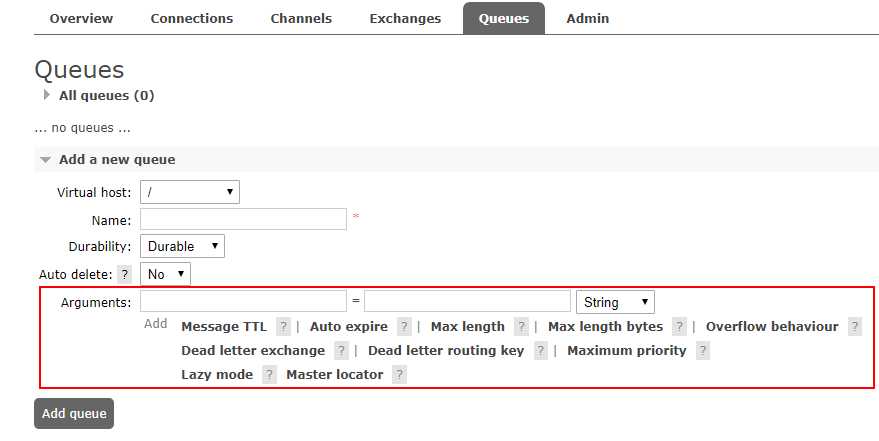
一共10个,鼠标点击"?",可以看到官方给出的解释.
官方 : How long a message published to a queue can live before it is discarded (milliseconds). (Sets the "x-message-ttl" argument.)
翻译 : 一个队列中的消息,在被丢弃之前能够存活多少毫秒.( key 为 "x-message-ttl").通俗讲就是,队列中的消息的生存周期,单位毫秒.
测试 :
internal class Program { private static void Main(string[] args) { Dictionary<string, object> arguments = new Dictionary<string, object> { { "x-message-ttl", 10000 } }; Producer.Send(arguments); Console.ReadKey(); } } public class Producer { private const string QueueName = "test_queue"; public static void Send(IDictionary<string,object> arguments) { using (IConnection connection = ConnectionHelper.GetConnection()) using (IModel channel = connection.CreateModel()) { channel.QueueDeclare(QueueName, false, false, false, arguments); string msg = "hello world "; channel.BasicPublish("", QueueName, null, Encoding.Default.GetBytes(msg)); Console.WriteLine($"{DateTime.Now} : send {msg}"); } } }
我们从管理页面该队列的消息概述中可以看出,这条消息只存活了10秒钟.

为了加以对比,我还另外创建了一个没有声明任何参数的队列:

可以看出,测试的这条队列的特征(Features)一栏中,被打上了"TTL"标签.
这里有个非常重要的知识点需要注意!
队列一旦声明,参数将无法更改,添加,删除,也就是说,对上述"test_queue"队列进行如下操作都会抛出异常:
Dictionary<string, object> arguments = new Dictionary<string, object> { { "x-message-ttl", 20000 } };
Dictionary<string, object> arguments = null;
Dictionary<string, object> arguments = new Dictionary<string, object> { { "x-message-ttl", 10000 } }; arguments.Add("x-expires", 12345);
通通不行!!!
要改变一个队列的参数,只有两种办法:
官方 : How long a queue can be unused for before it is automatically deleted (milliseconds).(Sets the "x-expires" argument.)
翻译 : 队列多长时间(毫秒)没有被使用(访问)就会被删除.换个说法就是,当队列在指定的时间内没有被使用(访问)就会被删除.
测试 :
private static void Main(string[] args) { Dictionary<string, object> arguments = new Dictionary<string, object> { {"x-message-ttl", 10000},//设置队列中的消息存活期为 10 秒 { "x-expires", 20000}//设置队列的存活期 20 秒 }; Producer.Send(arguments); Console.ReadKey(); }
可以看到,队列特征一栏中,多了一个"Exp"标签

当然,10秒后,消息会被删除,20秒后,队列被删除
但是,如果我们同时创建一个消费者,监听该队列,如下:
public class Consumer { private const string QueueName = "test_queue"; public static void Receive() { IConnection connection = ConnectionHelper.GetConnection(); IModel channel = connection.CreateModel(); EventingBasicConsumer consumer = new EventingBasicConsumer(channel); consumer.Received += (s, e) => { byte[] bytes = e.Body; string str = Encoding.Default.GetString(bytes); Console.WriteLine("consumer receive : " + str); }; channel.BasicConsume(QueueName, true, "", false, false, null, consumer); } }
private static void Main(string[] args) { Dictionary<string, object> arguments = new Dictionary<string, object> { {"x-message-ttl", 10000},//设置队列中的消息存活期为 10 秒 { "x-expires", 20000}//设置队列的存活期 20 秒 }; Producer.Send(arguments); Consumer.Receive();//创建一个消费者监听该队列 Console.ReadKey(); }
那该队列永远不会被删除.因为虽然它里面没有消息,但一直有消费者在使用(访问)它,所以它不会被删除.
官方 : How many (ready) messages a queue can contain before it starts to drop them from its head.(Sets the "x-max-length" argument.)
翻译 : 队列可以容纳的消息的最大条数,超过这个条数,队列头部的消息将会被丢弃.
测试 : 我们设置队列最多只能容纳 1 条消息,然后一次性发送10条,发送完毕后,创建一个消费者去消费,部分代码如下:
for (int i = 0; i < 10; i++) { string msg = "hello world " + i; channel.BasicPublish("", QueueName, null, Encoding.Default.GetBytes(msg)); Console.WriteLine($"{DateTime.Now} : send {msg}"); }
private static void Main(string[] args) { Dictionary<string, object> arguments = new Dictionary<string, object> { {"x-message-ttl", 10000},//设置队列中的消息存活期为 10 秒 { "x-expires", 20000},//设置队列的存活期 20 秒 {"x-max-length",1 },//设置队列中的消息的最大条数为 1 条,超过1条,则遵循队列的"先进先出(丢)"原则. }; Producer.Send(arguments); Thread.Sleep(1000); Consumer.Receive();//创建一个消费者监听该队列 Console.ReadKey(); }
运行结果:
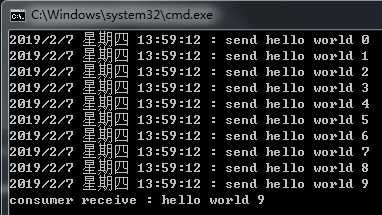
可以看到,消费者消费到的是"hello world 9", "hello world 0" - "hello world 8"都被队列丢弃了.
标签如下:

官方 : Total body size for ready messages a queue can contain before it starts to drop them from its head.(Sets the "x-max-length-bytes" argument.)
翻译 : 队列可以容纳的消息的最大字节数,超过这个字节数,队列头部的消息将会被丢弃.
测试 : 我们首先设置队列最多只能容纳12个字节.
Dictionary<string, object> arguments = new Dictionary<string, object> { {"x-message-ttl", 10000},//设置队列中的消息存活期为 10 秒 { "x-expires", 20000},//设置队列的存活期 20 秒 {"x-max-length-bytes",12 },//设置队列中的消息的最大字节数 };
接下来要分两种情况了:
string msg = "新年快乐啊"; channel.BasicPublish("", QueueName, null, Encoding.UTF8.GetBytes(msg)); Console.WriteLine($"{DateTime.Now} : send {msg}");

可以看到,消费者并没有收到消息.说明整条消息都被丢弃了,而不是想象中的只丢弃"新年快乐" ,剩个"啊".
channel.BasicPublish("", QueueName, null, Encoding.UTF8.GetBytes("新年快乐")); channel.BasicPublish("", QueueName, null, Encoding.UTF8.GetBytes("啊")); Console.WriteLine($"{DateTime.Now} : 消息发送完毕 ");

可以看到, 消费者收到了"啊".
队列标签如下 :

官方 : Sets the queue overflow behaviour. This determines what happens to messages when the maximum length of a queue is reached. Valid values are drop-head or reject-publish.
翻译 : 队列中的消息溢出时,如何处理这些消息.要么丢弃队列头部的消息,要么拒绝接收后面生产者发送过来的所有消息.( 从上面两个参数的测试中可以看出,"drop-head" 应该是默认行为) ,官方只给了 value,没给 key . key 为 "x-overflow".
测试 : 沿用 Max length 参数解释中的示例:
private static void Main(string[] args) { Dictionary<string, object> arguments = new Dictionary<string, object> { {"x-max-length",1 },//设置队列中的消息的最大条数为 1 条,超过1条,则遵循队列的"先进先出(丢)"原则. {"x-overflow","reject-publish" },//设置队列中的消息溢出后,该队列的行为:"拒绝接收"(所有消息) }; Producer.Send(arguments); Thread.Sleep(1000); Consumer.Receive();//创建一个消费者监听该队列 Console.ReadKey(); }
运行结果:
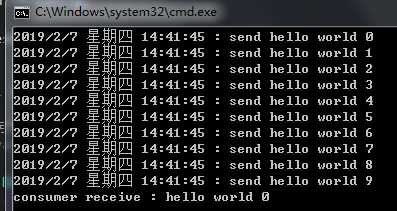
可以看到,这次消费者消费的是" hello world 0" ,不再是 "hello world 9" 了,因为生产者发送的"hello world 1" - "hello world 9"被队列拒绝了.
标签如下:

官方 : Optional name of an exchange to which messages will be republished if they are rejected or expire.(Sets the "x-dead-letter-exchange" argument.)
翻译 : 该参数值为一个(死信)交换机的名称,当队列中的消息的生存期到了,或者因长度限制被丢弃时,消息会被推送到(绑定到)这台交换机(的队列中),而不是直接丢掉.
对于这个参数,有两点需要特别注意:

所以,在测试前,我们需要创建一个队列,并绑定到该交换机.当然,交换机也需要提前创建好.
为了方便,我们在管理页面创建交换机和队列,并完成"绑定"动作.
1.先选择"Exchanges"标签

2.点击"Add a new exchange"标签.
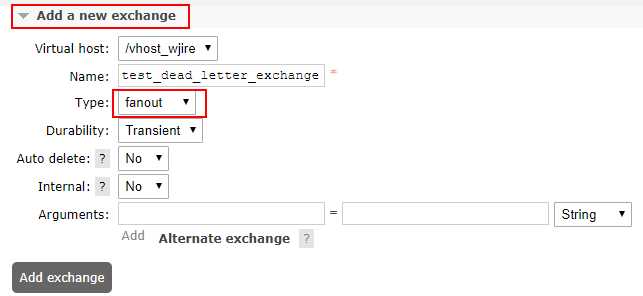
这里又要注意了,交换机类型我们要选择"fanout"模式.这种模式下,交换机会将生产者发送的消息分发到所有绑定到它的队列.细心的朋友应该能看出来为什么.
因为这个参数只是传入了交换机的名称,没有传入"Routing Key".
创建一个新队列 : "test_dead_letter_queue" ,图就不上了,开篇就已经提到了.
有两种方式:
1.在交换机详情页面输入要绑定的队列.

2.在队列详情页面输入要绑定的交换机.

上述工作都完成后,我们开始正式测试该参数.
我们设置队列可以容纳的消息最多1条,多的拒绝接收.
private static void Main(string[] args) { Dictionary<string, object> arguments = new Dictionary<string, object> { {"x-max-length",1 },//设置队列中的消息的最大条数为 1 条,超过1条,则遵循队列的"先进先出(丢)"原则. {"x-overflow","reject-publish" },//设置队列中的消息溢出后,队列的行为:"拒绝接收"(任何消息) {"x-dead-letter-exchange","test_dead_letter_exchange" }, }; Producer.Send(arguments); Thread.Sleep(1000); Consumer.Receive(); Console.ReadKey(); }
生产者的代码我们沿用 Max length 参数解释中的代码.
运行后,我们去看后台.

咦!?"test_dead_letter_queue"队列怎么一条消息都没有呢?
为什么交换机没有把 "test_queue" 丢弃的9条消息推送到该队列呢?
这是什么情况?
这就是这个参数第2个需要注意的点了.
Optional name of an exchange to which messages will be republished if they are rejected or expire.
个人觉得,官方这里用 rejected 不是太准确,当然,也可能是我理解得还不够深入,再加上英语太差.
为什么这么说呢?
我最开始的理解是 : 被拒绝或到期的消息会被推送到新的交换机,所以我在参数中传入了 {"x-overflow","reject-publish" }
我认为队列拒绝的这9条消息,就应该被交换机推送到绑定到它的队列去!
实际上,官方用词 "rejected" 应该被翻译成 : "丢弃"或者"抛弃",而不是"拒绝",也就是说,这里的 rejected 和 expire 是队列里面的消息的状态.而不是队列的动作.
当我们注释掉 {"x-overflow","reject-publish" } ,改用默认的 "drop-head" 行为时,运行一切正常:

关于到期( expire )的测试,这里就不上图了.
这个参数的标签是 : DLX
官方 : Optional replacement routing key to use when a message is dead-lettered. If this is not set, the message‘s original routing key will be used.(Sets the "x-dead-letter-routing-key" argument.)
翻译 : 略......
测试 :
我们先删除上述 "Dead letter exchange" 参数解释中创建的交换机及队列.
然后重新创建交换机 "test_dead_letter_exchange",并将其类型设置为"direct".(很多帖子叫它"直连模式"或者"路由模式",叫"topic"为"主题模式",但我更新喜欢叫"direct"为"精确匹配模式",叫"topic"为"模糊匹配模式",感觉好理解一些)
接着重新创建两个队列 "test_dead_letter_queue1" 和 "test_dead_letter_queue2",并将它们绑定到新的交换机.绑定的时候,将队列"test_dead_letter_queue1"的路由键设置为"test".

private static void Main(string[] args) { Dictionary<string, object> arguments = new Dictionary<string, object> { {"x-max-length",1 },//设置队列中的消息的最大条数为 1 条,超过1条,则遵循队列的"先进先出(丢)"原则. {"x-dead-letter-exchange","test_dead_letter_exchange" }, {"x-dead-letter-routing-key","test" }, }; Producer.Send(arguments); Console.ReadKey(); } }
运行结果及标签:

官方 : Maximum number of priority levels for the queue to support; if not set, the queue will not support message priorities.(Sets the "x-max-priority" argument.)
翻译 : 设置该队列中的消息的优先级最大值.发布消息的时候,可以指定消息的优先级,优先级高的先被消费.如果没有设置该参数,那么该队列不支持消息优先级功能.也就是说,就算发布消息的时候传入了优先级的值,也不会起什么作用.
测试 :
public class Producer { private const string QueueName = "test_queue"; public static void Send(IDictionary<string, object> arguments) { //构造消息的属性 RabbitMQ.Client.Framing.BasicProperties pros = new RabbitMQ.Client.Framing.BasicProperties(); using (IConnection connection = ConnectionHelper.GetConnection()) using (IModel channel = connection.CreateModel()) { channel.QueueDeclare(QueueName, false, false, false, arguments); for (byte i = 0; i < 10; i++) { string msg = "hello world " + i; pros.Priority = i; channel.BasicPublish("", QueueName, pros, Encoding.Default.GetBytes(msg)); Console.WriteLine($"{DateTime.Now} : send {msg}"); } } } }
上述代码表明,"hello world 0-9" 的优先级为 9 - 0.
需要注意的是,优先级属性的类型为 byte.
private static void Main(string[] args) { Dictionary<string, object> arguments = new Dictionary<string, object> { {"x-max-priority",255 }, }; Producer.Send(arguments); Thread.Sleep(1000); Consumer.Receive();//创建一个消费者监听该队列 Console.ReadKey(); }
运行结果:
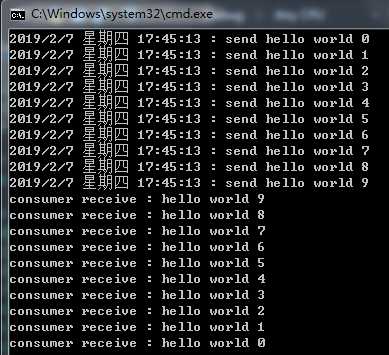
问题又来了,如果声明队列时,优先级最大值设置的是 5 ,那么这10条消息的消费顺序应该是怎样的呢?我们直接看结果:
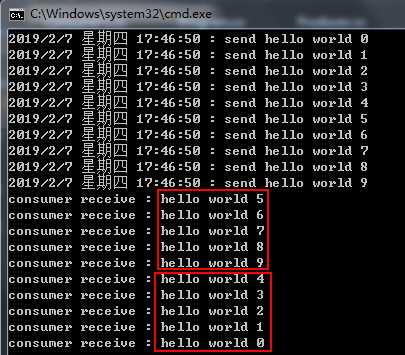
这个有点意思......
该参数的标签为 : Pri
官方 : Set the queue into lazy mode, keeping as many messages as possible on disk to reduce RAM usage; if not set, the queue will keep an in-memory cache to deliver messages as fast as possible.(Sets the "x-queue-mode" argument.)
翻译 : 设置队列为懒人模式.该模式下的队列会先将交换机推送过来的消息(尽可能多的)保存在磁盘上,以减少内存的占用.当消费者开始消费的时候才加载到内存中;如果没有设置懒人模式,队列则会直接利用内存缓存,以最快的速度传递消息.
测试 : 使用简单队列公平分发测试.
public class Producer { private const string QueueName = "test_queue"; public static void Send(IDictionary<string, object> arguments) { using (IConnection connection = ConnectionHelper.GetConnection()) using (IModel channel = connection.CreateModel()) { channel.QueueDeclare(QueueName, false, false, false, arguments); channel.BasicQos(0, 1, false); for (byte i = 0; i < 10; i++) { string msg = "hello world " + i; channel.BasicPublish("", QueueName, null, Encoding.Default.GetBytes(msg)); Console.WriteLine($"{DateTime.Now} : send {msg}"); } } } }
public class Consumer { private const string QueueName = "test_queue"; public static void Receive() { IConnection connection = ConnectionHelper.GetConnection(); IModel channel = connection.CreateModel(); EventingBasicConsumer consumer = new EventingBasicConsumer(channel); consumer.Received += (s, e) => { byte[] bytes = e.Body; string str = Encoding.Default.GetString(bytes); Console.WriteLine("consumer receive : " + str); channel.BasicAck(e.DeliveryTag, false); Thread.Sleep(5000);//5秒确认一条消息 }; channel.BasicConsume(QueueName, false, "", false, false, null, consumer); } }
private static void Main(string[] args) { Dictionary<string, object> arguments = new Dictionary<string, object> { {"x-queue-mode","lazy" }, }; Producer.Send(arguments); Thread.Sleep(10000); Consumer.Receive();//生产者消息发送完毕10秒后再创建消费者 Console.ReadKey(); }
运行结果:
当10条消息发送完毕后,我们看管理后台的队列详情:

可以非常清楚看到,内存中是没有任何消息的.总数和已准备都是130B.
130B怎么来的? "hello world 0" 一共13个字节,一共10条,13*10=130.
10秒后,消费者创建,并开始消费.

参数的标签为 : Args (这个标签有点特别...)
其实关于懒人模式和默认模式还有很多细节,各自的优缺点等.比如上面的例子,我故意让生产者一次性发了10条消息到队列,并且队列每次只传递一条到消费者,但是消费者开始消费的时候,队列就一次性把10条消息都读取到了内存.
再比如,持久化的消息与非持久化的消息,结合懒人模式等等.
还有默认模式和懒人模式的效率,性能比较等.
估计需要单独写个帖子了.
终于写到最后一个参数了
官方 : Set the queue into master location mode, determining the rule by which the queue master is located when declared on a cluster of nodes.(Sets the "x-queue-master-locator" argument.)
集群相关设置,暂时放一边去!
标签:producer 工作 nod ons reduce 总数 重要 修改 utf8编码
原文地址:https://www.cnblogs.com/refuge/p/10354579.html